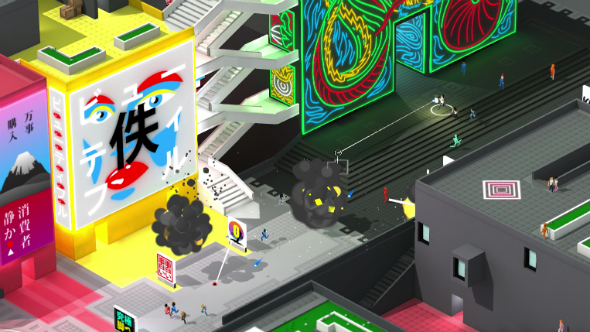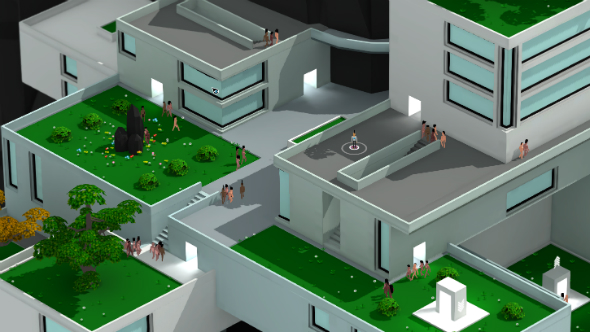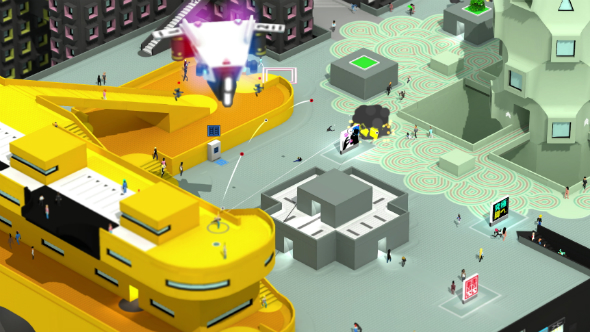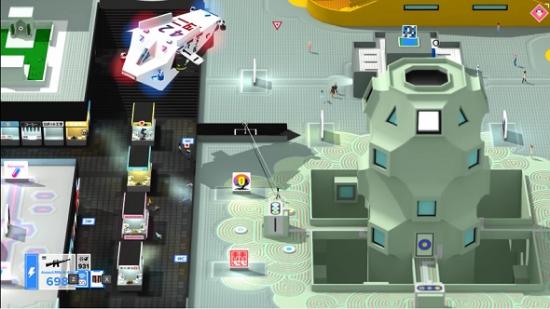Tokyo 42 is best described by its many influences: open-world gameplay right out of the original GTA, bullet physics that recall Worms, a rotatable isometric viewpoint a la Fez, and play-your-way assassination missions ripped straight out of Hitman. None of that matters though, because the first thing you’ll notice about it – and indeed the thing that stays with you longest – is that it’s absolutely gorgeous.
Related: for more open-world antics, check out the best sandbox games on PC.
Somehow, two-man team SMAC Games have crafted a version of Japan’s capital that’s more beautiful than Big Hero 6’s urban idyll, San Fransokyo. Every inch of the game’s sizeable sandbox is light and airy, not to mention impossibly clean, but there are human touches crammed into every open window, minute garden and communal square. Likewise, every district looks and feels wholly unique within the city. From the multiple faction strongholds to the suburban nooks and crannies, it’s obvious that Tokyo 42 has been made with painstaking dedication.

That visual style is mirrored by the game’s many gameplay mechanics – everything feels accessible, but there’s mastery to be had in every jump, long-range shot and stealthy infiltration. You play as a freelance assassin, taking on various hits in exchange for plot advancement and new gear. Missions range from beautifully simple kills, where you can literally walk up to your target and pull the trigger, to more elaborate assassinations where you can either try to silently infiltrate a stronghold, attempt an ambitious long-range kill – ambitious because of Worms-like bullet-time – or go full H.A.M, opening fire with a minigun and dodging incoming fire with laser-guided precision.
No strategy is easy, and often a blend of all three is required to get the job done. What makes these missions interesting is how seamlessly gameplay shifts from one extreme to the other. Miss your outrageous trick-shot and you’ll quickly find yourself trying to outrun a bullet hell-style onslaught. Likewise, get seen slinking between cover and the entire stronghold will be after you. There’s no awkward phase where you have to scramble into cover or sprint past a guard only to seek refuge in a locker or under a desk. Once you’ve been spotted, that’s your lot – you’ll just have to adopt a new approach. There’s no heavy-handed preference for any play style, and Tokyo 42 doesn’t stammer for a second when you switch from stealth to slaughter.

There are victory conditions such as completing the hit without being discovered, or just killing everyone in the mission area. These feed into the game’s gear progression component, giving you additional money to spend in the Tokyo 42’s many assassin-friendly stores. These purchasable weapons – like a silenced sniper rifle called Hush NAU, and a cluster bomb that releases a seemingly endless chain of additional cluster bombs – give the player plenty of incentive to go back over old missions. In an incredibly unsubtle nod to – yes, again – Worms, you can even buy bananas in the weapon stores, except they don’t explode, although developers SMAC Games do express hope that the bananas will one day make civilians slip and fall over.
That’s just a small insight into Tokyo 42’s whimsical side. A more bombastic example of that can be seen in the game’s ridiculous, hidden-away racing and drive-by shooting mechanics. At this point in the demo a race track descends suddenly from the sky, held aloft by colourful bunches of balloons. The player then magically appears on a motorbike – “Oh, there are motorbikes in Tokyo 42 by the way,” adds director and coder Sean Wright – and races some incomprehensibly stupid AI opponents on the bizarre track in the sky. The player then steers the bike off the track and into the city, pulls out an assault rifle and opens fire on the city’s denizens. None of this functions gracefully within the context of an isometric game with a spinnable map, and the motorbike’s handling attests to Wright’s claim that they only added the feature as a fun tidbit for players rather than a serious mechanic.
Then there are the enemy factions themselves, some gleeful combinations of Japanese tropes like a gang of business tycoons who practice Yakuza-like rituals and congregate around a dojo-cum-temple, others – a militant nudist colony is the first to spring to mind – are simply a little more… inspired. There’s a real clash of serious and silly going on in in every aspect of the game, but fortunately it’s endearing, rather than chaotic.

There’s even an Assassin’s Creed style multiplayer component to delve into on the side, which pits two players against each other in an incredibly condensed map that’s packed with civilians both players can hide amongst. There are no penalties for killing bystanders, but making the first move is very dangerous in a game where one bullet kills. It’s hard to see it becoming much more than a fun competitive option for friends to mess about in, but it’s an option that’s received plenty of love from the developers, with a number of very detailed custom maps already in place for the game’s early 2017 launch.
There’s a narrative and fiction loosely underpinning everything too, nods to films like Blade Runner and a cloaking mechanic that owes its existence to Linklater’s A Scanner Darkly. None of these elements jumped to the fore during the demo, but they gave the world a flavour and richness that complemented the pristine visuals. Exactly how important the narrative is to the appeal of the game is still questionable, but that’s really not an issue when you can start an apocalyptic showdown just by throwing a banana at a nudist.
As intriguing as its world is, and as finely balanced and flexible as the gameplay is, it’s that first glimpse of Tokyo 42 that’ll decide how well it does when it goes on sale. Good thing it’s a looker, then.
